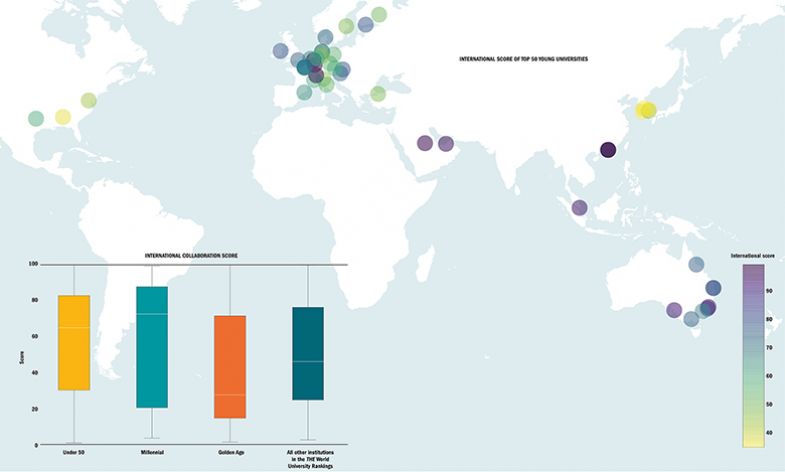Browse the THE Young University Rankings 2019 results
Internationalisation is a trend that has increasingly dominated the missions and strategies of universities in the 21st century, whether they were established in the past 50 years or the past 400.
But have newer institutions found it easier to adapt to the increasingly global higher education landscape than their older counterparts?
The “box and whiskers” chart on this page suggests that universities established within the last half century tend to be more successful on at least one measure of internationalisation: cross-border research collaboration.
Each plot shows how universities’ scores for international co-authorship are distributed in the Times Higher Education World University Rankings for four different groups: Golden Age universities (those established in the post-war era between 1945 and 1967), young universities (those aged 50 and under), millennials (institutions set up since 2000) and the remaining institutions in the table.
Millennial universities tend to have the highest scores, shown by the greater reach of the group’s box (which represents the interquartile range of the scores) while the wider set of young universities also appears to be ahead of the entire pack of ranked institutions.
However, despite being newer than many of the world’s elite universities, Golden Age institutions seem to lag behind the wider rankings group with the group’s median score (shown by the solid line) being particularly low.
This last observation could be due to many of the universities in this group being in countries that generally do not score as highly for international collaboration for various reasons, with Japan being a key example.
The importance of national location to a university’s internationalisation efforts is further emphasised by the map, which shows scores in the international outlook pillar (a combination of metrics on shares of international staff, students and cross-border collaboration) for the top 50 institutions in the Young University Rankings.
Universities with the highest scores in the pillar tend to be located in major global hubs for international higher education, such as Hong Kong, Singapore and Switzerland, while those that score poorly tend to be in countries known to be more sluggish on internationalisation, including South Korea and the US.
Register to continue
Why register?
- Registration is free and only takes a moment
- Once registered, you can read 3 articles a month
- Sign up for our newsletter
Subscribe
Or subscribe for unlimited access to:
- Unlimited access to news, views, insights & reviews
- Digital editions
- Digital access to THE’s university and college rankings analysis
Already registered or a current subscriber? Login








